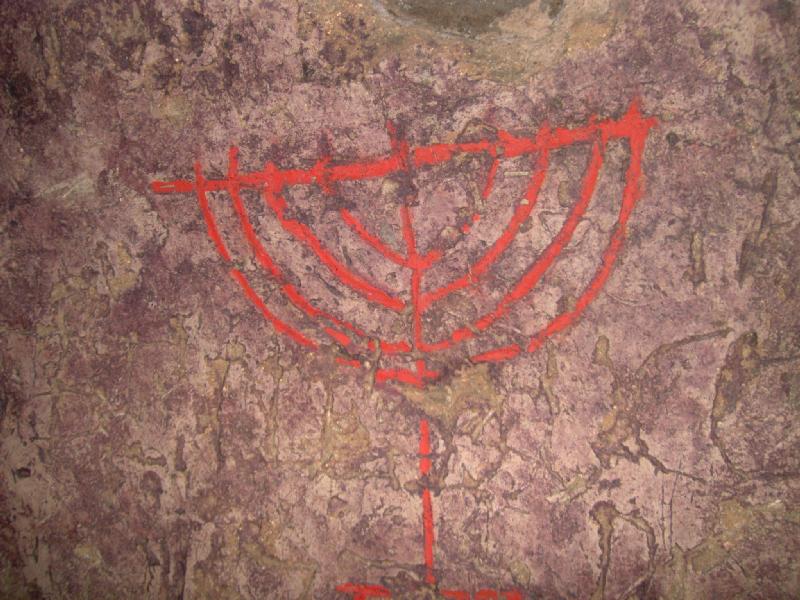|
Jewish Catacombs Of Venosa
The Jewish Catacombs of Venosa are a set of catacombs located near the Italian city of Venosa, Province of Potenza, on Maddelena Hill. Description The exact date of construction for the catacombs is unknown, but it seems likely that they were built and used between the . They were discovered in 1853 and were not systematically studied until 1974. The structure of the catacombs is simple, with two parallel tunnels connected by passages. Most of the names listed in the catacombs reflect the tendency of Jewish diaspora to take Greek or Latin names as opposed to names in Hebrew, with only a small minority of the people buried there having names reflecting a Hebrew etymology. The earliest writing in the catacombs is usually in Koine Greek, with Latin existing in the newer and deeper sections of the catacombs. There is more Hebrew text in these catacombs than in the better known Jewish catacombs of Rome. Religious iconography Iconography, as a branch of art history, studie ... [...More Info...] [...Related Items...] OR: [Wikipedia] [Google] [Baidu] |
Catacombs Of Rome
The Catacombs of Rome ( it, Catacombe di Roma) are ancient catacombs, underground burial places in and around Rome, of which there are at least forty, some rediscovered only in recent decades. Though most famous for Christian burials, either in separate catacombs or mixed together, Jews and also adherents of a variety of pagan Roman religions were buried in catacombs, beginning in the 2nd century AD,Toynbee: 39–40. occasioned by the ancient Roman ban on burials within a city, and also as a response to overcrowding and shortage of land. The most extensive and perhaps the best known is the Christian Catacomb of Callixtus located near the Park of the Caffarella, but there are other sites, both Christian and not, scattered around the city, some of which are now engulfed by modern urban sprawl. The Christian catacombs are extremely important for the history of Early Christian art, as they contain the great majority of examples from before about 400 AD, in fresco and sculpture, as ... [...More Info...] [...Related Items...] OR: [Wikipedia] [Google] [Baidu] |
Jewish Cemeteries
A Jewish cemetery ( he, בית עלמין ''beit almin'' or ''beit kvarot'') is a cemetery where Jews are buried in keeping with Jewish tradition. Cemeteries are referred to in several different ways in Hebrew, including ''beit kevarot'' (house of sepulchers), ''beit almin'' (eternal home) or ''beit olam aba'' (house of afterlife), the ''beit chayyim'' (house of the living) and ''beit shalom'' (house of peace). The land of the cemetery is considered holy and a special consecration ceremony takes place upon its inauguration. According to Jewish tradition, Jewish burial grounds are sacred sites and must remain undisturbed in perpetuity. Establishing a cemetery is one of the first priorities for a new Jewish community. A Jewish cemetery is generally purchased and supported with communal funds. Placing stones on graves is a Jewish tradition equivalent to bringing flowers or wreaths to graves. Flowers, spices, and twigs have sometimes been used, but the stone is preferred bec ... [...More Info...] [...Related Items...] OR: [Wikipedia] [Google] [Baidu] |
Jewish Catacombs
Jews ( he, יְהוּדִים, , ) or Jewish people are an ethnoreligious group and nation originating from the Israelites Israelite origins and kingdom: "The first act in the long drama of Jewish history is the age of the Israelites""The people of the Kingdom of Israel and the ethnic and religious group known as the Jewish people that descended from them have been subjected to a number of forced migrations in their history" and Hebrews of historical Israel and Judah. Jewish ethnicity, nationhood, and religion are strongly interrelated, "Historically, the religious and ethnic dimensions of Jewish identity have been closely interwoven. In fact, so closely bound are they, that the traditional Jewish lexicon hardly distinguishes between the two concepts. Jewish religious practice, by definition, was observed exclusively by the Jewish people, and notions of Jewish peoplehood, nation, and community were suffused with faith in the Jewish God, the practice of Jewish (religious) la ... [...More Info...] [...Related Items...] OR: [Wikipedia] [Google] [Baidu] |

